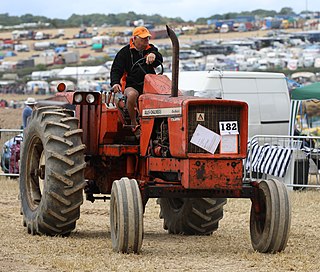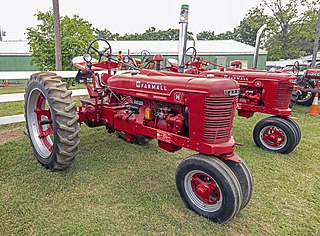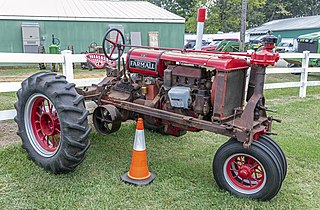
A tractor is an engineering vehicle specifically designed to deliver a high tractive effort at slow speeds, for the purposes of hauling a trailer or machinery such as that used in agriculture, mining or construction. Most commonly, the term is used to describe a farm vehicle that provides the power and traction to mechanize agricultural tasks, especially tillage, and now many more. Agricultural implements may be towed behind or mounted on the tractor, and the tractor may also provide a source of power if the implement is mechanised.

Deere & Company, doing business as John Deere, is an American corporation that manufactures agricultural machinery, heavy equipment, forestry machinery, diesel engines, drivetrains used in heavy equipment, and lawn care equipment. It also provides financial services and other related activities.

The Allis-Chalmers One-Ninety XT, also known as the 190XT, is a row crop tractor produced by Allis Chalmers from 1964 to 1971. The tractors are powered by diesel fuel, gasoline, or LP gas. As its model number implies, it was based on the Allis-Chalmers D19 from the D Series, though it featured many alterations and improvements over the D19. The only difference between the 190 and the 190XT is the addition of a turbocharger on the 190XT diesels. Gasoline-run 190XT's also have a G2800 engine as opposed to the 190's G2500 engine. The stock 190XT is rated at about 93 PTO horsepower.

The Allis-Chalmers D series is a line of tractors made by the Allis-Chalmers Manufacturing Company from 1957 to 1969.

The International Harvester 1066 is a farm tractor that was made by International Harvester from 1971 to 1976. The 1066 has a six-cylinder diesel engine and about 105 drawbar and 125 PTO horsepower. The 1066 is significant for its popularity, with over 50,000 units having been built in its six-year run.

John Deere 3020 is a tractor that was manufactured by John Deere as part of its New Generation series from 1964 to 1972. The 3020 is nearly identical to the John Deere 3010 model that it replaced. It has a wheelbase of 90 inches, and a fuel capacity of 29 gallons. It was offered with three different engine options including a 3.7L 4-cyl gasoline engine, a 4.4L 4-cyl diesel and a 3.7L 4-cyl LP gas engine all produced by John Deere. The 3020 was rated at 71 horsepower. Transmission options included the standard Synchro Range transmission that offered 8 forward speeds and two reverse speeds and an optional eight speed power shift transmission. Several different tread options were offered by John Deere on the 3020 including, standard, narrow front Row Crop, narrow front Row Crop with "Roll-O-Matic", wide front Row Crop, Row Crop Utility. and Orchard.

The Farmall H is a medium-sized two-plow row crop tractor produced by International Harvester under the Farmall brand from 1939 to 1954. It was the most widely produced of International Harvester's "letter series", with approximately 390,000 produced over the 14-year run. It succeeded the Farmall F-20. The H was incrementally updated with new model numbers as the Super H, 300, and 350, but remained essentially the same machine. The original H used an International Harvester C152 4-cylinder in-line engine. Production of all versions lasted until 1963.

The Farmall M is a large three-plow row crop tractor produced by International Harvester under the Farmall brand from 1939 to 1953. It was of International Harvester's "letter series". It succeeded the Farmall F-30. The M was incrementally updated with new model numbers as the MD Super M, Super MD Super M-TA, but remained essentially the same machine. The original M used an International Harvester C248 4-cylinder in-line engine. Production of all versions lasted until 1954, when it was replaced by the Farmall 400 which was essentially the same machine with updated sheet metal.

The Mack Granite is a series of heavy duty and severe service trucks built by Mack Trucks. It has a long, low-profile hood and a high-visibility cab. Designed as straight trucks for local construction, waste removal, and other vocational jobs, it is also available as a semi-tractor. Introduced in 2001, it remains in production as of today.

The Farmall C is a small two-plow row crop tractor produced by International Harvester under the Farmall brand from 1948 to 1951. The C was developed from the Farmall B as a slightly larger, more versatile implement, raising and moving the B's offset operator seat to the centerline and increasing the wheel size to allow a straight, widely-adjustable rear axle. The C kept the International Harvester C123 engine that had been used in the Super A model. The tractor was heavier and more robust, and featured hydraulic capability from the beginning. The C was incrementally updated with new model numbers as the Super C, 200, 230 and 240, but remained essentially the same machine. The closely related successors to the C were produced until 1962.

The Farmall F-20 is a medium-sized two-plow row crop tractor produced by International Harvester under the Farmall brand from 1932 to 1939, with approximately 148,000 produced. It replaced the Farmall Regular, and was itself replaced in 1939 by the Farmall H.

The Farmall F-12 is a small two-plow row crop tractor produced by International Harvester under the Farmall brand from 1932 to 1938, with approximately 123,000 produced. An improved model, the two-plow F-14, was produced beginning in 1938 and ending in 1939, when the Farmall letter series tractors were introduced.

The Farmall 06 series tractors are a family of row-crop tractors with six-cylinder engines, providing greater horsepower than the parallel product line of four-cylinder Farmall 04 series tractors. Until the late 1950s, Farmall and parent company International Harvester tractors used four-cylinder engines for general-purpose and row-crop tractors. Demands for higher performance and greater horsepower led to broader use of six-cylinder engines, with the bulk of International's production moving to the larger engines. The Farmall 806 and 706 were introduced in 1963, with production running to 1967. The Farmall 1206 was introduced in 1965 as the most powerful tractor of its time, using a turbocharged diesel engine. Production of the 1206 also ran until 1967. The 06 series sold well and was regarded as extremely successful.

The John Deere Model GP tractor was a two-plow, and later a three-plow row-crop tractor produced by John Deere from 1928 to 1935. Initially called the John Deere Model C, the name was changed to GP as a result of difficulties in distinguishing between the Model C and Model D over the telephones of the time. It was intended as a response to the Farmall Regular line of general-purpose tractors produced under the Farmall brand by International Harvester..

The John Deere Model B tractor was a two-plow row-crop tractor produced by John Deere from 1935 to 1952, with direct successors produced until 1960. The B was a scaled-down, less expensive version of the John Deere Model A. It was followed by the updated 50, 520 and 530 models.

The John Deere Model G tractor was a large three-plow row-crop tractor produced by John Deere from 1937 to 1953, with successor models produced until 1961. It was followed by the 70, 720, and 730.

The John Deere Model R tractor was John Deere's first diesel tractor. A large, heavy tractor, it had fixed wheel widths and was not produced as a row-crop tractor with adjustable axles. The R was followed in the John Deere numbered model series by the John Deere 80, 820 and 830 tractors, which represented evolutionary upgrades to the basic R.
The Oliver 80 row-crop tractors was a model of agricultural tractors produced from 1938 to 1963 by the Oliver Farm Equipment Company. The model 80 was a development of the Oliver Hart-Parr industrial tractor, for agricultural use. The initial 80 was rated for three 14-inch plows, making it a medium-sized tractor. By the time the Super 88 development was introduced, it was rated for six plow bottoms, making it a heavy tractor.
The Oliver 90 series of row-crop tractors was a series of agricultural tractors produced from 1937 to 1961 by the Oliver Farm Equipment Company. Beginning with the Hart-Parr 28–44, the series was the most powerful Oliver tractor offering, capable of heavy plowing. Initial development proceeded on parallel lines, with the 28–44 offered with low and high-compression engine options that became the Oliver 90 and 99, respectively. The lines merged with the Super 99, then diverged again with the 950, 990 and 995 models. The series was produced until 1961.





















